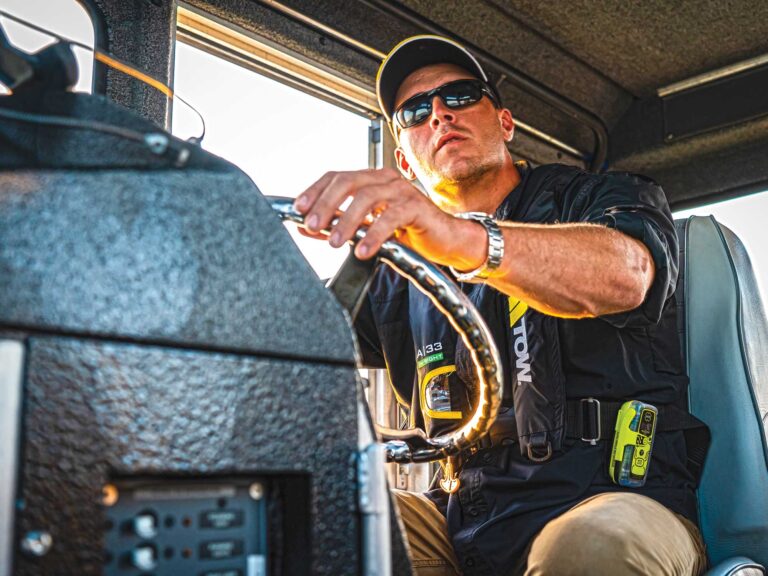Humans have been designing waterborne vessels since a hungry caveman found a deep river between himself and a tasty-looking baby brontosaurus.
As time progressed, man used boats and ships of all sorts to provide food, generate wealth and advance culture. Those who captained and crewed these vessels achieved legend status, from humble Inuit paddling a qajaq in pursuit of walrus to the Viking berserkers in longships, to Age of Discovery explorers. Yes, we know the myth, lore and legend of the vessels and those who manned them. But what about the designers? Do you think the Portuguese would have fished the Grand Banks atop the same lash-up of logs that Og used to get a bronto burger?
Naval architects work in the background, mostly unknown except by their peers. However, they have an important impact. Are there new frontiers in pleasure boats? Who are the designers pushing the needle with respect to how we enjoy speed, safety, comfort and efficiency? We think these three have had, and will continue to make, a lasting impact on recreational boat design.

John Deknatel
Hull Visionary
John Deknatel is most recognized for perfecting and maintaining Ray Hunt’s vaunted deep-V hull design. Owner and president of C. Raymond Hunt Associates, Deknatel began working for the respected yacht designer Philip Rhodes in the early 1960s, while he was still studying at Harvard. After graduating he went into business with Ray Hunt in ’66.
Deknatel asserts that maintaining and improving a successful concept are challenges many naval architects face today. Interior and exterior trends often compromise a hull’s design integrity. Changing the beam, even slightly, can often change the way a boat handles in a seaway. “There are plenty of good designers,” he explains. “Interior features and topside amenities are driving many of their designs at the expense of hull performance. I focus on the hull; that is why the boats I design tend to have simpler, more traditional interior layouts and exterior styling.”
This approach is the secret to the success of such respected boats as Hunt Yachts, Sabre and the Grand Banks East Bay series. Deknatel was instrumental in these commuter-style and picnic boat designs. “I think one of the boats I am most proud of is the East Bay 38,” he says. “I think we captured the sailboaters’ aesthetic in the simple and straightforward design and again later with the East Bay 49.”
One of Deknatel’s contributions to boating today is optimizing the same basic geometry for different boat requirements and missions — explaining, for instance, how the hulls of a 50-foot pilot boat and a 50-foot motoryacht need to be designed according to the unique form and function of the two widely different uses.
Deknatel says he thinks new technology and innovations are what will continue to drive design. New lightweight materials and processes are creating lighter, stronger hulls. Pod drives and joystick controls are revolutionizing the way people perceive boat ownership, with more joystick options for every type of engine setup from inboards to sterndrives to pods and now even outboards. New innovations have made diesel engines cleaner, quieter and more efficient than just a decade ago. Larger displacement outboards are showing up on large cruisers and fish boats. All these innovations are making boating easier, more enjoyable and safer.
When asked what he consistently strives for when designing a new boat, Deknatel responds, “Rough-water capabilities, dryness and efficiency.” He points to Grady-White as an example of these attributes. Deknatel and C. Raymond Hunt and Associates have been involved in the design of Grady-White hulls for many years.
C. Raymond Hunt Associates and John Deknatel own a rich history of rough-water-designed boats for military, commercial and recreational use up to 120 feet. Deknatel deeply appreciates the classic designs of Rhodes and Sparkman & Stevens, noted for drawing seakindly boats appreciated by experienced mariners. One can see that influence in many of Deknatel’s designs today.

Lou Codega
The Sea Keeper
Lou Codega has been designing boats for more than three decades. Two of his best-known designs are the Carolina Classic 28 and the Regulator 26. Beyond deep-V sport-fishing boats, he furthered the “form stable” concept developed by naval architects Jay Benford and Philip C. Bolger by applying the principles that those luminaries developed to the Great Harbour line of trawlers.
“I admire everyone in our profession; everybody has contributed to the greater knowledge. To me, it is extending those great ideas and applying them in the real world of oceans and seaways,” Codega explains, “taking what is known and developing innovative concepts that improve performance and safety.”
Codega discovered his passion at a young age. When he was 12, his parents brought him from their home in Barrington, Rhode Island, to the America’s Cup race in Newport, a short distance away. This was in the time when you could join the crew celebrating the day’s victories and losses at pubs like the Black Pearl. Intrepid, skippered by Emil “Bus” Mosbacher, won the first of two consecutive America’s Cups in 1962. Codega was so enamored of the beautiful hull lines and tall rigs that he decided he would someday design a yacht that beautiful and powerful.
Studying naval architecture and marine engineering, Codega graduated with a Bachelor of Science from Webb Institute, an engineering college that has specialized in the subjects for more than 124 years. He went on to the Massachusetts Institute of Technology (MIT) to earn a master’s degree in 1981 in the same field of study. With the United States economy not yet recovered from the recession caused by the ’70s oil embargo, there were not a lot of opportunities to design sleek racing yachts. Codega found himself designing icebreakers for the Coast Guard and also powerboats for the U.S. Navy.
Donald Blount (perhaps most famous for Destriero, a 224-foot power yacht that holds the nonstop transatlantic record, averaging 55 knots in 1992; and for his work with the U.S. Navy’s Combatant Craft Division in the development of high-speed boats and shock mitigation for crews aboard such craft) had the greatest influence on Codega’s developing career. Codega worked for Blount for eight years.
Asked what drives him more than any aspect of design, Codega replies, “Seakeeping. That is always in the forefront of my thinking. Whether on a high-performance offshore center-console or a long-range trawler, seakeeping is the key to safe and enjoyable boating experiences.”
Codega characterizes commendable seakeeping as a boat that has a smooth, comfortable ride, one that is dry and does not slam into waves and chop — a hull that is stable, tracks straight and is predictable at speed.
Pressed, Codega speaks plainly.
“Anyone can slow down to avoid the pounding and unpredictability of a poorly set up hull,” explains the respected designer. “To get it right, one must pay attention to every little detail. The size and angle of the chines, the bow entry angle to deadrise transition geometry, the shape and length of strakes, beam-to-length ratio, as well as weight distribution and balance: They all play a part in creating a great riding boat with exceptional seakeeping abilities.”

Bob Dougherty
Mr. Unsinkable
I first interviewed the irrepressible Bob Dougherty more than 20 years ago. He had retired from Boston Whaler in 1990, after 30 years of involvement in every Whaler designed since he began working for Dick Fisher in 1960. Fisher and Dougherty were bitten by the fiberglass bug of the late ’50s, but went in different directions.
Following in his father and brother’s footsteps, Dougherty became a teacher in the 1950s, teaching industrial arts in Boston’s public school system. Bemoaning his small salary, he began working for Brunswick Manufacturing (not the same Brunswick of today) in 1959, when the company had 15 employees in North Quincy, Massachusetts, making medical devices such as artificial eyeballs and hips. Arthur Godfrey had his hip made there.
At the same time, Fisher, along with naval architect Ray Hunt (that name again!), started experimenting with a foam-filled fiberglass sandwich boat based on the 1913 Sea Sled design of Albert Hickman with refinements to the basic shape that made the boat ride softer.
Fisher and Dougherty met at the 1960 Boston Boat Show and decided to partner. During the ensuing 30 years Dougherty evolved the Whaler concept from nine feet to 27 feet, constantly tweaking and improving the ride.
However, it was the way Whalers were and still are made that makes them unique. The decks and hulls are laminated in strong, heavy metal molds that are designed to fit together like a clamshell. At key points, liquid foam is forced into the space between the laminations, expanding to fill all the voids. The molds have to be clamped tightly together because, when the foam cures, it puts tremendous heat and pressure on the molds. The foam adds strength, and in cases when the outer hull is compromised, even sheared in half, it will continue to be buoyant. Thus, Boston Whaler became known as “The Unsinkable Legend.”
When Irwin Jacobs tried to perform a hostile takeover of Boston Whaler from then-owner Charlie Leighton in 1989, Leighton decided to sell the company to Reebok. The shoemaker had ideas on how to move the company forward. They did not mesh with Bob Dougherty’s. He retired.
In 1992 Bob once again had an idea that would change boat design. Most production boats at the time (and today, in fact) were built on the “shoebox” principle. The hull is the box and the deck is the lid. Like a shoebox, the top and the box are not terribly stable by themselves and can twist easily. As the theory goes, when the top is placed on the box, there is greater stability. However, as Dougherty states, that puts a lot of pressure on the joint between the deck and the hull, often causing failure of the joint.
Daugherty wanted to build boats with inherently stable hulls that did not need the deck for strength. He developed a grid system out of fiberglass that bonded into the hull, creating a solid structure that would handle seas without a deck. Bob along with his son, Steven, formed a new company, EdgeWater Boats, which began delivering center-console models in 1992.
After five years Dougherty left EdgeWater Boats and started making strong, lightweight hardtops for several boat manufacturers using a new technology he invented called Rapid Molded Core Assembly Process, or RAMCAP. The process starts with high-density foam that is precisely shaped and then placed in a mold that has the gelcoat applied and the fiberglass pre-laid. Resin is then added, and a vacuum system clamps the assembly universally and precisely controls the glass-to-resin ratio.
Dougherty decided that he could make a complete boat with this method of hardtop construction that would be stronger and lighter than its predecessors. He sold the idea to his former company, in the form of the EdgeWater 14, the first RAMCAP boat. It was so successful it won the National Marine Manufacturers Association (NMMA) Innovation Award in 1999. Dougherty then founded Everglades Boats, which currently builds both recreational and commercial vessels using the vaunted RAMCAP construction.
The New Frontier
Reflecting upon the thoughts that Deknatel, Codega and Dougherty shared, several themes emerged. All three related how designing boats requires a mastery of multiple disciplines, from hydrodynamics and mathematics to manufacturing and more. All three recounted how safety, reliability and good performance on the water rank higher than accommodations in a design’s priorities. All three maintain that there are still new frontiers to explore, and new discoveries and refinements to make, in the ever-evolving world of recreational boat design.









